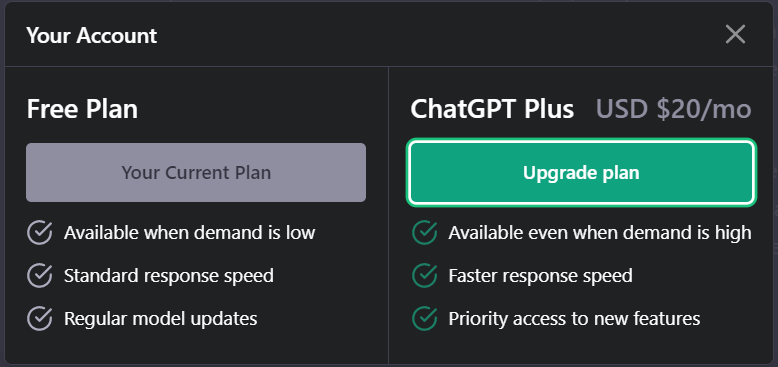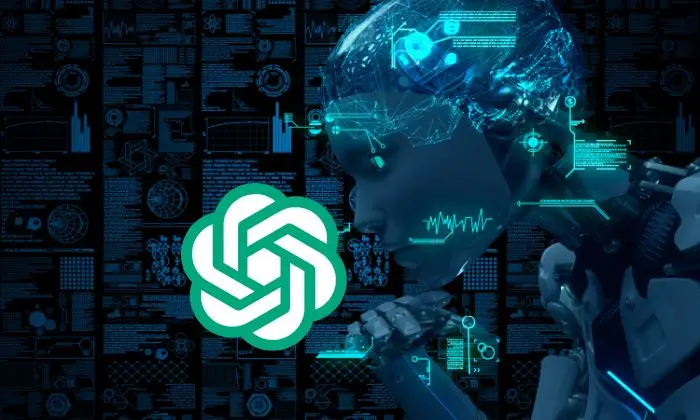Chat GPT was launched on 30 November 2022 by OpenAI – an Artificial Intelligence research and deployment company. An incredible fact about Chat GPT is it reached 100 million users in the two months of its launch and 13 million plus daily active users.
What is Chat GPT?
Chat GPT, a language model developed by OpenAI, is a research organization focused on artificial intelligence (AI). It is a computer program trained using a deep learning algorithm to understand and generate human-like responses to natural language queries and inputs. Its training is based on a large text dataset, allowing me to generate coherent and contextually appropriate responses to a wide range of topics and questions. It is designed to simulate conversation and provide users with information, guidance, and assistance.
Development in Chat GPT is based on deep neural networks and natural language processing (NLP) techniques that allow for understanding and generate human-like responses to written text.
Chat GPT training data consists of a vast amount of text from various sources, including books, articles, and websites, which cover a wide range of topics. This training data helps to understand the nuances of language, including sentence structure, grammar, and context, which allows for generating coherent and relevant responses to a wide range of questions.
Chat GPT can understand and generate text in 108 languages, but proficiency in each language may vary depending on the amount and quality of training data available for that language.

Who created Chat GPT?
Chat GPT is a creation of OpenAI, an artificial intelligence research company. OpenAI is a team of researchers, engineers, and scientists who work together to advance the field of AI and develop new technologies to benefit society. Elon Musk has also contributed a major part to this invention. The development of Chat GPT was a collaborative effort by a team of researchers and engineers at OpenAI, and any single individual did not create it.
Some of the key individuals who played a significant role in the development of the GPT (Generative Pre-trained Transformer) architecture, which forms the basis of Chat GPT, include:
- Alec Radford: Research Scientist at OpenAI who led the development of GPT-2, the predecessor to Chat GPT.
- Ilya Sutskever: Co-founder of OpenAI and Director of Research, who has significantly contributed to developing deep learning techniques and architectures, including the GPT model.
- Sam Altman: Former CEO of OpenAI who has been instrumental in guiding the company’s vision and mission to develop safe and beneficial AI.
- Greg Brockman: Current CEO of OpenAI who oversees the development and deployment of OpenAI’s research and technology.
- Jeff Dean: Senior Fellow at Google and pioneer in machine learning, who has contributed to developing deep learning techniques and models that have influenced the GPT architecture.
- Andrew Ng: Co-founder of Google Brain and former Vice President of Baidu, who has significantly contributed to developing deep learning techniques and architectures, including the GPT model.
How to sign in ChatGPT, follow these step-by-step instructions:
- Open a web browser: Launch your preferred web browser on your computer or mobile device.
- Visit the OpenAI website: Go to the official OpenAI website by typing “openai.com” in the address bar of your web browser and pressing Enter.
- Navigate to the ChatGPT page: Once you’re on the OpenAI website, navigate to the ChatGPT page. You can usually find it in the main menu or by searching for “ChatGPT.”
- Click on “Sign In”: On the ChatGPT page, look for the “Sign In” or “Log In” button and click on it. This will typically be located in the upper right corner of the page.
- Enter your credentials: You will be directed to the login page. Enter your username or email address and your password in the respective fields. If you have previously signed up using a third-party authentication provider, you might have the option to log in using that service (such as Google or GitHub).
- Complete any additional verification: Depending on your account settings, you might be asked to complete additional verification steps, such as solving a captcha or confirming your identity through email or SMS.
- Click on “Sign In” or “Log In”: Once you have entered your credentials and completed any necessary verification, click on the “Sign In” or “Log In” button to proceed.
- Access your ChatGPT workspace: After successfully signing in, you will be redirected to your ChatGPT workspace. Here, you can start interacting with the model, inputting prompts, and receiving responses.
That’s it! You have successfully signed in to ChatGPT and can now enjoy using the language model for various tasks and conversations.
Some examples of the types of queries you can ask include:
- Informational queries
- Definitions and explanations
- Creative writing assistance
- Problem-solving
- Conversational engagement
- Language-related queries
- Educational assistance
To use ChatGPT effectively
- Clearly define your query
- Use context and provide details
- Break down complex questions
- Experiment with temperature settings
- Use system messages for guidance
- Evaluate and iterate
- Fact-check and verify information
- Keep the conversation on track
- Practice ethical use
- Provide feedback
| Information | Explanation |
|---|---|
| GPT-4 is OpenAI’s most advanced system | GPT-4 is the latest deep learning language model developed by OpenAI |
| Produces safer and more useful responses | GPT-4 is 82% less likely to respond with disallowed content and 40% more likely to produce factual responses than GPT-3.5 |
| Solves difficult problems with greater accuracy | GPT-4 has broader general knowledge and problem-solving abilities |
| More creative and collaborative | GPT-4 can generate, edit, and iterate with users on creative and technical writing tasks |
| Long context | GPT-4 can process and understand longer context for more accurate responses |
| Outperforms ChatGPT in advanced reasoning capabilities | GPT-4 scores in higher approximate percentiles among test-takers |
| Trained with human feedback | GPT-4 was trained with more human feedback, including feedback from ChatGPT users and experts in AI safety and security |
| Continuous improvement from real-world use | GPT-4 will be updated and improved regularly based on real-world usage |
| Used in collaboration with various organizations | GPT-4 has been used by organizations such as Duolingo, Morgan Stanley, and Khan Academy |
| Research and Infrastructure | GPT-4 was trained on Microsoft Azure AI supercomputers and represents the latest milestone in OpenAI’s effort to scale up deep learning models |
You can use ChatGPT-4 for free on Bing easily!
Where can Chat GPT be used?
Chat GPT can be used in various fields where natural language processing and conversation are important. Below I have listed the top 16 fields where Chat GPT can be used.
Chat GPT in Customer Service:
To create chatbots and virtual assistants that can handle basic customer inquiries and provide support. For example, a company could use Chat GPT to create a chatbot that can answer frequently asked questions, such as “What are your store hours?” or “Do you offer free shipping?” This can help free up customer service representatives to handle more complex inquiries while still providing a high level of support for customers.
Chat GPT in Education:
Chat GPT can be used to answer students’ questions and provide explanations of various topics. For example, a tutoring service could use Chat GPT to create a virtual tutor that can answer questions about math, science, or other subjects. This can provide students with on-demand support and help them better understand difficult concepts.
Chat GPT in Healthcare:
Chat GPT can be used to provide information about medical conditions and treatments and answer common health-related questions. For example, a health insurance company could use Chat GPT to create a virtual assistant that can help members find in-network providers, answer questions about claims, and provide information about preventive care.
Chat GPT in Finance:
Chat GPT can be used to provide financial advice, answer questions about banking and investments, and assist with financial planning. For example, a bank could use Chat GPT to create a virtual financial advisor that can provide personalized investment recommendations based on a customer’s goals and risk tolerance.
Chat GPT in E-commerce:
In e-commerce, it provides product recommendations, answers questions about products and services, and assists with online shopping. For example, an online retailer could use Chat GPT to create a chatbot that can suggest products based on a customer’s browsing and purchase history and answer questions about shipping and returns.
Chat GPT in Travel:
Chat GPT can be used to provide travel recommendations, answer questions about destinations and accommodations, and assist with booking and planning. For example, a travel agency could use Chat GPT to create a virtual travel advisor that can suggest destinations based on a customer’s preferences and provide information about local attractions and activities.
Chat GPT in Marketing:
Chat GPT can be used to generate personalized marketing content, such as product descriptions and promotional messages, and provide customer insights and feedback. For example, a marketing agency could use Chat GPT to create custom social media posts and email campaigns that are tailored to a specific audience.
Chat GPT in Entertainment:
Chat GPT can be used to create interactive games and quizzes, generate personalized movie or music recommendations, and provide information about events and performances. For example, a streaming service could use Chat GPT to create a virtual assistant that can recommend movies and TV shows based on a customer’s viewing history, and answer questions about upcoming releases.
Chat GPT in Human resources:
Chat GPT can be used to answer employee questions about benefits, policies, and procedures, and provide guidance on career development and training opportunities. For example, a company could use Chat GPT to create a virtual HR assistant that can provide information about employee benefits, answer questions about company policies, and suggest professional development opportunities.
Chat GPT in Legal:
Chat GPT can be used to provide legal advice, answer questions about legal procedures and documents, and assist with legal research. For example, a law firm could use Chat GPT to create a virtual legal assistant that can answer common legal questions, such as “What are my rights if I’ve been injured in a car accident?” or “What is the process for filing for bankruptcy?”
Chat GPT in Social media:
Chat GPT can be used to create chatbots that can interact with users on social media platforms, answer common questions, and provide support. For example, a social media management company could use Chat GPT to create a chatbot that can answer questions about a brand’s products or services, provide information about upcoming promotions or events, and offer customer support through direct messaging.
Chat GPT in Real estate:
Chat GPT can be used to answer questions about properties, provide information about neighborhoods and communities, and assist with real estate transactions. For example, a real estate agency could use Chat GPT to create a virtual assistant that can help prospective buyers find properties that meet their criteria, provide information about local schools and amenities, and answer questions about the home buying process.
Chat GPT in Journalism:
Chat GPT can be used to generate news stories and summaries, fact-check information, and assist with research and data analysis. For example, a news organization could use Chat GPT to create a tool that automatically generates news stories based on data from public sources, or fact-checks information in real time to provide accurate reporting.
Chat GPT in Gaming:
Chat GPT can be used to create conversational agents within video games, providing a more immersive and engaging gaming experience. For example, a game developer could use Chat GPT to create virtual characters that can interact with players, offer hints and guidance, or provide personalized gameplay experiences.
Chat GPT in Research:
Chat GPT can be used to assist with data analysis, generate research summaries, and provide insights and recommendations. For example, a research institution could use Chat GPT to create a tool that automatically summarizes research papers, or analyze large datasets to identify patterns and trends.
Is ChatGPT free or paid?
Chat GPT can be used to support fundraising efforts, answer questions about programs and services, and provide resources and referrals for community members in need. For example, a non-profit organization could use Chat GPT to create a virtual assistant that can answer common questions about the organization’s mission and programs, offer guidance to people in need of support, and provide information about upcoming events and volunteer opportunities.
Chat GPT free plan vs Chat GPT plus
Free plan (GPT-3.5):
- Available when demand is low
- Standard response speed
- Regular model updates
Chat GPT plus (GPT-4):
- Available even when demand is high
- Faster response speed
- Priority access to new features

Chat GPT plus subscribers will get early access to GPT-4, the latest version of Chat GPT.
Advantages and disadvantages of Chat GPT
Advantages of ChatGPT:
- ChatGPT is equipped with Natural Language Processing capabilities, enabling it to understand and interpret human language in a more natural and intuitive way than traditional chatbots.
- It can personalize user interactions, creating a more engaging and personalized experience that helps build stronger customer relationships.
- It is a general-purpose AI model that can be adapted to a wide range of applications, from customer service to marketing, education, and more.
- ChatGPT is available 24/7, which means that customers can get the help they need at any time of day or night.
- It can learn from past interactions and improve its responses over time, leading to better performance and a more accurate understanding of user needs.
- It can be a cost-effective alternative to human customer service representatives, allowing businesses to reduce labor costs while still providing high-quality customer support.
- It can be easily scaled to handle large volumes of customer inquiries, making it an ideal solution for businesses with rapidly growing customer bases.
- ChatGPT can provide consistent and reliable responses to customers, eliminating the risk of human error or variability in performance.
- It can be trained in multiple languages, allowing businesses to support customers from a variety of different regions and linguistic backgrounds.
Disadvantages of ChatGPT:
- ChatGPT can be susceptible to bias, as it is trained on large datasets of text data that may contain harmful stereotypes or inaccuracies.
- While ChatGPT can understand and interpret human language, it lacks the emotional intelligence to pick up on subtler cues that humans rely on to communicate, such as tone of voice and body language.
- As with any technology, ChatGPT poses potential security risks, including hackers’ ability to exploit system vulnerabilities or steal sensitive data.
- ChatGPT may struggle to understand complex or nuanced topics that require a deeper understanding of context, making it less suitable for certain types of interactions.
- ChatGPT’s performance heavily depends on the quality and quantity of training data it receives, which can limit its accuracy and effectiveness in certain situations.
- While ChatGPT can generate contextually relevant and grammatically correct responses, it may lack the creativity and spontaneity of human interactions, making it less engaging and enjoyable for some users.
- It may struggle to respond accurately to queries requiring specialized domain knowledge, such as technical support inquiries or legal advice.
- ChatGPT may struggle to handle complex queries that require multiple steps or interactions, leading to frustration or confusion for users.
- It may struggle to interpret ambiguous or unclear input from users, leading to misunderstandings or incorrect responses.
Conclusion
ChatGPT represents a significant advancement in artificial intelligence, offering a powerful and versatile tool for businesses and individuals seeking to communicate more effectively with machines. With its natural language processing capabilities, personalization, versatility, and 24/7 availability, ChatGPT has the potential to revolutionize customer service, marketing, education, and many other domains.
However, it is essential to be conscious of the potential limitations and risks associated with ChatGPT, such as potential bias, lack of emotional intelligence, and security risks. Furthermore, while ChatGPT offers many advantages over traditional chatbots, it may only be suitable for some types of interactions, particularly those that require specialized domain knowledge or a nuanced understanding of context.
FAQs about Chat GPT
What is Chat GPT?
ChatGPT is a large language model trained by OpenAI based on the GPT-3.5 architecture. It is designed to understand and respond to natural language queries conversationally.
How does ChatGPT work?
ChatGPT uses machine learning algorithms to analyze and understand natural language queries. It then searches its vast database of information to generate the most relevant response to the query.
Can ChatGPT be used for commercial purposes?
Yes, ChatGPT can be used for commercial purposes. However, adhering to ethical guidelines when using AI models for commercial gain is important.
Is ChatGPT able to generate original content?
Yes, ChatGPT is capable of generating original content, such as articles, summaries, and even poetry. However, the quality and accuracy of this content may vary depending on the specific task.
Can ChatGPT be used for educational purposes?
Yes, ChatGPT can be used for educational purposes, such as answering questions, providing explanations, and offering study materials. However, it is important to verify the accuracy of the information provided by ChatGPT before using it for educational purposes.
What are the limitations of ChatGPT?
ChatGPT has some limitations, such as its inability to understand certain nuances of language, the potential for biased responses based on its training data, and the possibility of generating incorrect or inappropriate responses. It is important to keep these limitations in mind when using ChatGPT.







0 Comments